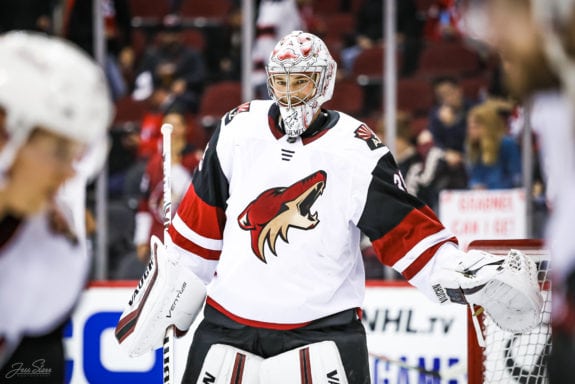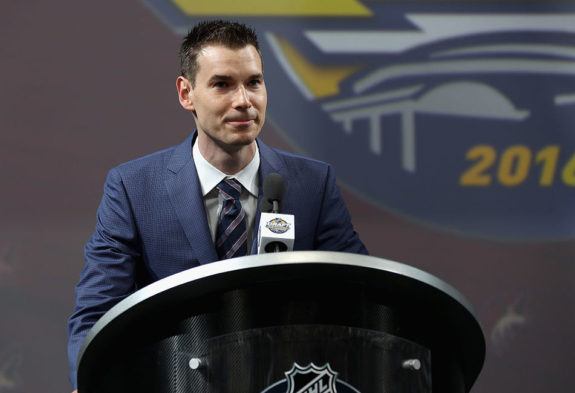It’s no secret that Arizona Coyotes forward Michael Grabner has struggled badly so far during the 2019-20 NHL regular season.
Grabner has played in just 45 of Arizona’s 61 games this year, and has been a regular healthy scratch as of late, as he’s participated only 6 of 19 contests since the calendar flipped to 2020. During that span, he’s recorded no points, four shots on net, and a minus-four rating while playing an average of 10:20 per night.

Grabner’s recent struggles have led to speculation as to the cause, as well as questions of whether he might be moved at the Feb. 24 trade deadline in order to give general manager John Chayka some extra room under the salary cap as he looks to improve his roster as much as possible for the playoff push.
Is Injury Affecting Grabner?
One of the reasons for Grabner’s down 2019-20 season could be the effects of a serious injury that the veteran suffered in a game at Gila River Arena against the St. Louis Blues back on Dec. 1, 2018.
That night, Grabner suffered significant damage to his right eye after being inadvertently high-sticked by Blues’ forward Sammy Blais during action in the game’s opening period. Play was immediately halted, and Grabner was able to leave the ice surface with assistance from Arizona’s training staff. Slow-motion replays indicated that Blais’ stick ended up getting underneath Grabner’s protective visor, and the result was not pretty:
Prior to the eye injury, Grabner was off to an otherworldly start in his first season with the Coyotes after signing as a free agent in the summer of 2018. He had “just” 11 points overall through his first 24 games in the desert, but six of them – four goals and two assists – came while Arizona was shorthanded. Grabner was generating a shorthanded scoring chance seemingly every night, and, more often than not, turned them into goals.
Grabner and his primary penalty-killing partner Brad Richardson combined for seven goals and three assists while killing penalties over the months of October and November, and, for a while, it was more exciting to see the Coyotes at work on the PK than it was to see them on the power play.
Through the first 24 games of the season, Grabner and Richardson had led the Coyotes to the league’s No. 1 penalty-kill percentage, and the club actually had a net penalty-kill percentage of 102.6 percent at that point in the year. That’s right – the Coyotes generated more shorthanded goals for (10) than they allowed power-play goals against (8). Their shorthanded goal differential of plus-two was nine goals better than the next best team, the San Jose Sharks, at minus-seven.
Then came the frightening eye injury. Grabner missed 41 games as he recovered and adjusted to the vision changes that resulted. Grabner returned to action with the Coyotes on March 7, 2019, with a permanently dilated right pupil and a new tinted visor to aid in his vision on the ice.
Grabner played all 16 of Arizona’s remaining games in 2018-19, registering, of course, two more “shorties,” including this one on March 9 against the Los Angeles Kings:
Grabner added an even-strength goal and two assists as well over the Coyotes’ stretch run, giving him five points in 16 games after returning from his eye injury, and 16 points in 41 games overall in 2018-19.
Things haven’t gone as well this season, though – Grabner has been on the scoresheet just 11 times through 45 contests, and The Athletic‘s Craig Morgan wrote in a recent article that Grabner’s eye injury may be affecting his on-ice performance “more than he is letting on” (from ‘Coyotes monthly mailbag: You asked, we tried to answer,’ The Athletic, 2/13/2020).
Grabner has managed to generate a ton of breakaways and scoring chances this season with his tremendous hockey sense, anticipation, and speed, but, for the most part, he hasn’t been able to finish those chances off. In another Morgan piece at The Athletic, Grabner stated that, while he’s adjusted to the injury as much as he can, “it’s still different than it used to be and it never will be the same so I’ve got to deal with that” (from ‘Michael Grabner, Christian Fischer and more: The life and mind of a healthy scratch’, The Athletic, 1/16/2020).
This quote very well could lead one to suspect that the eye injury is having an impact in Grabner’s play, although he still has eight goals this season after posting nine last season. He’s still been a relatively productive player, but, after recording back-to-back 27-goal seasons in 2016-17 and 2017-18 and scoring at a 21-goal pace though the first 24 games in 2018-19, Grabner has recorded just 11 goals in 61 games since the eye injury. That’s a 14-goal pace over 82 games, and is a fairly significant drop-off.
Could Grabner Be Moved?
Grabner’s on-ice struggles, as well as his $3.35 million cap hit, have led to questions regarding his future in Arizona. With Team Canada World Junior Championships hero Barrett Hayton set to rejoin the Coyotes after a conditioning/rehab stint with the AHL’s Tucson Roadrunners, an already crowded Arizona forward group will add one more body for Grabner to contend with.
As a result, the Coyotes may be inclined to move Grabner at the deadline and use the $3.35 million in cap space that he currently is eating up to acquire another veteran bottom-four defenseman and/or a bottom-six forward to aid in the club’s playoff push. The team as currently constructed appears to be, at best, a fringe contender in the Western Conference without goaltender Darcy Kuemper in net.

There’s no timetable for Kuemper’s return from a lower-body injury that he initially suffered back on Dec. 19 (and re-aggravated on Feb. 10), though, so the Coyotes can’t count on getting their No. 1 netminder back with enough time for him to make a significant impact on the team’s playoff hopes. Chayka will need to improve the rest of the roster in order to give his club a better chance at earning a spot in the 2020 Stanley Cup playoffs.
At present, the Coyotes are nearly capped out, as they have less than $400,000 in cap space. That’s not nearly enough room to add a player, so someone will need to be moved off of the current roster if Chayka has inclination to make additions prior to the deadline. It’s likely that he’ll want to leave the team’s group of current contributors untouched, which leaves Grabner as the best option if the need arises to move salary.

As unfortunate as the situation is, this is a business, and Chayka’s job is to give his team the best possible chance to have success. Grabner is a true professional, is a pleasure to watch play the game of hockey (especially while on the penalty kill), and has dealt with the eye injury probably better than anyone else in the league could have, but it might be time for the Coyotes to move on from the 32-year-old Austrian.
If Arizona fails to make the playoffs after giving up multiple prospects and draft picks (including their 2020 first-rounder) to acquire 2018 Hart Trophy winner Taylor Hall from the New Jersey Devils, this season will undoubtedly be looked back upon as a colossal failure. Will Chayka make a move to give his team a better chance in a relatively weak Pacific Division? If he does, Grabner might find himself changing addresses in a few days.